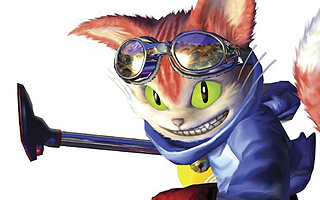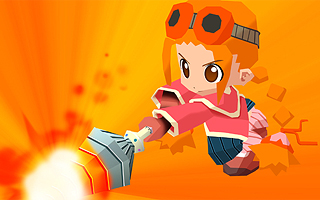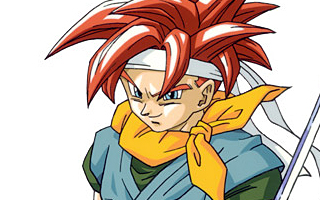Game Changers of the 1980s
Top 10 Most Important Video Games of the 1980s!
For this list, we’re counting down the most important video games of the 1980s. The ’80s was a decade of excess in many ways. Movies were getting bigger, music was getting louder, and everyone used way too much hairspray. The video game market was also expanding, but the industry suffered through some growing pains. As we entered the decade, the Atari VCS was a pop culture phenomenon and the arcade scene was booming. Greed and complacency ultimately caused the market to crash in 1983, and many analysts wrote the entire video game scene off as a fad. Fortunately, the experts were wrong. The Nintendo Entertainment System revived the console market in the latter half of the decade, innovative games were filling arcades, and PC gamers were given ample reason to look down on console peasants. Handheld gaming was also on the rise by the end of the decade, thanks in no small part to the Game Boy and a certain Soviet mind game. The industry had its ups and downs, but the 1980s made it clear that video games were here to stay. For the purpose of this list, we’re looking for games that inspired change within the industry. Rather than list the best or most creative games, we’re looking for titles that helped the medium grow and evolve.
10
E.T. The Extra Terrestrial
1982

With Steven Spielberg’s E.T. The Extra Terrestrial dominating the box office in 1982, Atari saw a way to make some easy money in the holiday season. Hoping to capitalize off of the record-breaking success of the film, Atari paid $20 million for the exclusive licensing rights and quickly rushed the game into production. Programmers had less than six weeks to complete the game, and Atari was so determined to get it onto store shelves before the holiday season that they opted to forgo audience testing altogether. The end result is universally regarded as one of the worst video games of all-time. Spielberg had suggested that Atari produce something along the lines of Pac-Man, but they delivered a convoluted mess of an adventure game with unresponsive controls and ambiguous objectives. This was in an era where video game magazines didn’t exist, most video stores didn’t rent games, and Al Gore had not yet invented the Internet. It was difficult for the general public to tell which games were good, and games like E.T. had made it patently clear that they couldn’t trust advertising campaigns. Consumers couldn’t be sure which games were worthwhile, so they were more likely to spend $5 on a discounted game than drop $35 on a new one. Nobody wanted to risk their money on a new game, so the once-fledgling industry was crippled by widespread bankruptcy in 1983 and 1984. Games like E.T. were not even fit for the bargain bin, so truckloads of unsold cartridges were secretly buried in a New Mexico landfill. E.T. cannot be entirely blamed for the video game crash, but it represents everything that was wrong with the industry in the early 1980s.
9
Double Dragon
1987

Double Dragon is a legendary beat ’em up in which you must fight your way through the mean streets of a post-apocalyptic New York in order to rescue your kidnapped girlfriend. The game was a spiritual successor to Renegade, but it introduced several genre-defining elements. During the game, gang members would relentlessly attack you with various weapons, including knives, whips, and lead pipes. Players were also free to use weapons, and this set Double Dragon apart from other games of the era. The level designs were less straightforward that most beat ’em ups, and the stages were filled with various pitfalls and obstacles for the players to overcome. The most significant contribution the game made to the genre was its inclusion of two player co-op. There were a few exceptions – like Mario Bros. and Bubble Bobble – but the most popular arcade games from the era were usually single-player affairs. Any game that allowed for two people to play at the same time was obviously going to be a hit with arcade owners. The game was a hit with the gaming audience as well, and Double Dragon opened the floodgates for multiplayer brawlers. Companies like Capcom, Konami, and Sega were quick to adopt the winning formula, and Technos continued to push the genre forward in the years that followed. The genre lost its luster by the mid ’90s, but side-scrolling beat ’em ups ruled the arcade scene for many years.
8
The Portopia Serial Murder Case
1983

For most of the people reading this, The Portopia Serial Murder Case is the most obscure game on this list. The landmark adventure game was designed by Yuji Horii and published by Enix, but it was never released outside of Japan. The game tasks players with unraveling a murder mystery by finding clues, exploring different areas, interacting with characters, and solving various puzzles. Portopia featured first-person graphics, an open-world design, branching dialogue options, numerous plot twists, and a surprise ending. The non-linear approach gave players multiple ways to achieve their objectives, and it felt like you actually had a stake in the story. As one of the first real detective games, its influence can be seen in everything from Snatcher to L.A. Noire. Mystery House is generally recognized as the first graphical adventure game, but the storytelling techniques in Portopia were more sophisticated and the game had a much larger impact on the industry. Games like Zork, King’s Quest, and Maniac Mansion all pushed the adventure genre to new places, but Portopia basically built the framework for visual novels and its influence was more widespread. Hideo Kojima has praised the game for expanding the potential of the medium, and it would be hard to argue otherwise. Visual novels account for over half of the PC games released in Japan, and they all owe something to Portopia.
7
SimCity
1989

While working on Raid on Bungeling Bay, Will Wright realized that he enjoyed designing maps with the development tools more than he enjoyed playing the game itself. Wright was fascinated by urban planning, so he decided to use sophisticated level editors as a foundation for a new game. Released in 1989 on various home computers, SimCity was an open-ended game that let players design their own city. Players could allocate space for residential, commercial, and industrial zones, and it was their responsibility to build power grids and establish a transportation system for their city. As mayor, you were encouraged to keep an eye on the crime rate and pollution levels, and you also had the ability to set the tax rate and allocate resources accordingly. Ostensibly, the point of the game was to grow your city and attract as many people as possible. The main game had no set objective, however, and there was technically no way to win or lose. You were free to set your own goal if you were so inclined, but there was not a right way to play the game. Will Wright described SimCity as a “software toy” rather than a video game, while Nintendo’s Satoru Iwata described it as a “non-game game.” It was one of the first titles that truly let you play at your own pace, so nobody was sure how to categorize it. The open-ended nature of SimCity allowed for a greater degree of self expression than most games, and its success encouraged the industry to give players more creative freedom.
6
The Legend of Zelda
1986

The Legend of Zelda was a launch title for the Famicom Disk System in 1986. When it was released on cartridge the following year, it came included with an internal battery for saving data. The game was too long to be played in a single sitting, and this made it stand out from most games on the market. The revolutionary adventure game was developed concurrently with Super Mario Bros., and a concerted effort was made to ensure that the games would be radically different from one another. Zelda featured a vast overworld and nine maze-like dungeons, and the game was filled with hidden doors and secret passages. It was noteworthy for its open-ended nature, and players could explore the world as they saw fit. You had to acquire certain items or power-ups to reach certain areas, but the progression was non-linear and you could finish the dungeons in any order you wanted to. You could even make it all the way to the final boss without obtaining the sword that was offered at the beginning of the game! Some of the secrets were vague or ambiguous, but this was an intentional design choice. Players weren’t expected to find everything on their own. Instead, The Legend of Zelda encouraged players to communicate with each other outside of the game and share their findings. Although it was a single-player game, it was also a social experience. The Legend of Zelda didn’t necessarily look any different from typical NES games, but it was unlike anything I had ever played before and it felt like a generational leap in terms of its overall scope.
5
Dragon Quest
1986

Dragon Quest is the grandfather of Japanese role-playing games. It wasn’t the first game in the genre, however, and it drew obvious inspiration from western RPGs like Wizardry and Ultima. During the development of the game, Yuji Horii and his team at Chunsoft made a concerted effort to step away from the statistical nature of RPGs and focus instead on simplified gameplay elements. Up until that point, RPGs were aimed primarily at hardcore fans, so Horii wanted to create a game that everyone could play. The game’s menu-driven battles were simple enough for anyone to understand, and turn-based battles emphasized strategy over reflex. There were only a handful of towns to visit and less than a dozen spells to learn, but the game was emotionally involving and it always gave the player a sense of purpose. With a cast of memorable characters, a captivating story, and unforgettable enemies designed by the legendary Akira Toriyama, Dragon Quest was much more charming than other RPGs from the era. Games like Final Fantasy and Phantasy Star were created in the wake of Dragon Quest‘s success, and it became commonplace for developers to shoehorn RPG elements into other genres. Enix moved two million copies of the game in Japan alone, but it failed to catch on in the west even though Nintendo was literally giving it away. It would take a while for America to warm up to the genre, but this didn’t lessen Dragon Quest‘s impact on the industry. It’s the reason why JRPGs are entwined with anime art styles even to this day.
4
Donkey Kong
1981

Shooting games were all the rage during the golden age of the arcades, and Nintendo attempted to cash in on the craze with the release of Radar Scope. Based on its initial popularity in Japan, Nintendo ordered 3,000 units for its North American launch. Unfortunately, the buzz had already died before it reached US soil and Nintendo found themselves with a warehouse full of unwanted arcade cabinets. Since everyone else was busy with other projects, Nintendo turned to a young staff artist named Shigeru Miyamoto to design a new game that could help move the unsold Radar Scope cabinets. Miyamoto lacked the technical background to program it himself, but he brought a fresh perspective to the design phase. Working closely alongside Nintendo’s chief engineer, Gunpei Yokoi, Miyamoto exceeded all expectations with the creation of Donkey Kong. Several aspects set Donkey Kong apart from other games of the day. In an era where most games had the simple objective of scoring the most points, Donkey Kong actually had some semblance of a storyline and gave the gamers a real goal. The game featured four diverse stages, and it even employed simple cut scenes to advance its plot. It also featured innovative game mechanics. Donkey Kong was one of the first games to feature a jump button. This concept was so revolutionary in 1981 that Miyamoto wanted to patent the idea! Donkey Kong put Nintendo on the map, and it effectively created a new genre. It also marked the debut of the most prolific video game character of all-time, but we’ll be hearing more about that guy later.
3
Pac-Man
1980

In recent years, publishers have been ramping up their efforts to appeal to female audiences. This is by no means a new trend. In 1979, Toru Iwatani of Namco noticed that the vast majority of arcade-goers were male, so he sought a way to cast a wider net. When his independent research suggested that girls spent an inordinate amount of time talking about food, he decided to build a game around the concept of eating things. The goal in Pac-Man is to navigate through mazes and eat as many dots as you can. You’ll be pursued by four ghosts along the way, but you will be able to eat them too if you obtain special power-ups. Most games up to that point were focused on sports or shooting things, but eating was a universal concept that appealed to both genders alike. Pac-Man helped increase the appeal of video games with female audiences, and it also impacted the industry in other ways. It established a new genre of “maze chase” games, it featured one of the industry’s first recognizable mascots, and it was one of the first games to see broad licensing success. It also helped popularize concepts like power-ups and cutscenes. Pac-Man has been ported to dozens of gaming platforms and has appeared in over 30 different spin-offs, but its reach extends beyond the gaming sphere. Within a few years of its release, the game had inspired an animated TV series, a best-selling record, and myriads of merchandise. There was even a Pac-Man cereal! Pac-Man has the highest brand awareness of any video game character among American consumers, and not even Mario is more recognizable.
2
Tetris
1984

Video game publishers often try to appeal to as many people as possible, but few games have had a wider reach than Tetris. The earliest version of the game was created in 1984 by a Soviet engineer named Alexey Pajitnov. Pajitnov was tasked with evaluating the capabilities of new computers at a national research academy, and he’d often design simple games to test the hardware. He wanted to design a game based around the pentomino puzzles he enjoyed as a kid, but the project became too complicated since there were too many different shape configurations to deal with. Instead, he designed a game based around tetrominoes, and this served as the basis of Tetris. If you’re unfamiliar with the game, the purpose is to manipulate a series of falling blocks so they create solid lines across the entire playing field. By rotating the blocks and shifting their position in an appropriate fashion, you can prevent them from reaching the top of the screen. As in life, your mistakes will pile up and make things more difficult for you down the road. Tetris was popular with Pajitnov’s colleagues, and everyone who picked up the game saw its potential. There was a lot of drama around licensing, but the game was eventually ported to PCs, arcades, and home consoles. The Game Boy version was especially noteworthy, and it helped cement Nintendo as the dominant force in handheld gaming. The reason why Tetris was so successful was that it appealed to everyone. The premise of the game was simple enough for anyone to understand, and its replay value was almost limitless. You could sit down and play the game for hours on end, and it was also an ideal game to play when you had ten minutes of downtime. Whether you were a student on the playground or an executive in an office building, Tetris provided countless hours of entertainment.
1
Super Mario Bros.
1985

By 1985, the video game industry as a whole was becoming boring and uninspired. Gamers and retailers alike had been burned by bad games, and many were ready to give up on the hobby altogether. When Super Mario Bros. came along, everything changed. At a time when most games still took place on single screens, Super Mario Bros. boasted 32 expansive levels that actually scrolled when the player moved! These stages were loaded with myriads of breakable bricks, secret item blocks, trampolines, secret beanstalks, and hidden warp zones. The game was also full of iconic power-ups and memorable enemies. Although Super Mario Bros. was one of the most advanced games of its day, it certainly wasn’t in a league of its own. Ghosts ‘n Goblins, for example, pushed the envelope every bit as far as Super Mario Bros. did and was released in the same month. What set Super Mario Bros. apart from most games of the era, however, was that it wasn’t designed with an “arcade mentality” in mind. Since it was necessary for arcade owners to make money, typical video games were exceedingly difficult. Super Mario Bros., on the other hand, was clearly designed for home audiences, so Nintendo didn’t have to concern themselves with finding ways to kill the player every 30 seconds.Super Mario Bros. marked the beginning of a paradigm shift in which the industry focus was moved away from the arcades and onto home consoles. The game wasn’t only effective in launching a console, it was also effective in re-launching an entire industry. The North American console market crashed at the end of 1983, but Super Mario Bros. brought it back from the dead and helped propel the newly-minted Nintendo Entertainment System into the stratosphere.





Do you agree with this list? Let us know what you think by leaving a comment below. Your opinion matters!